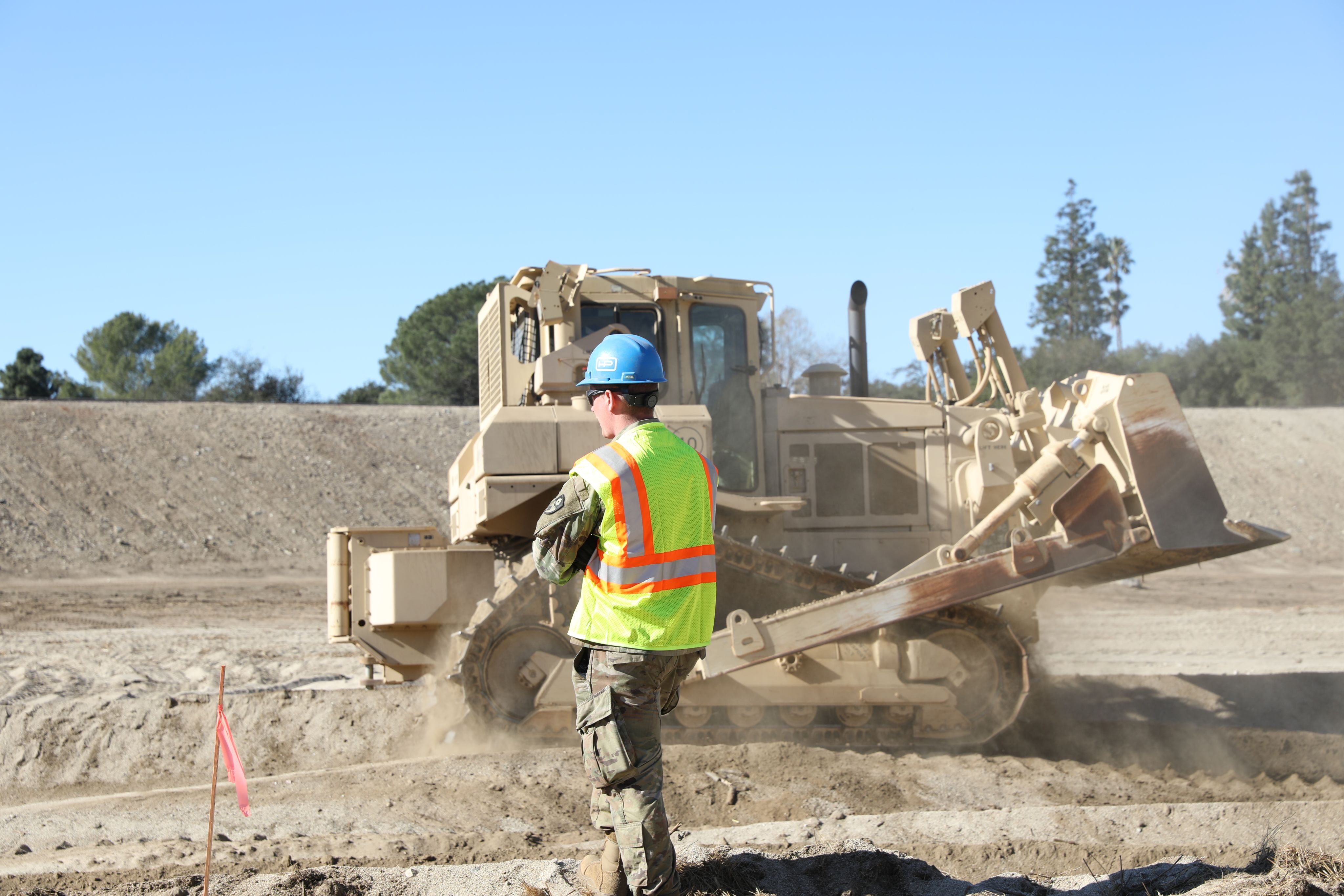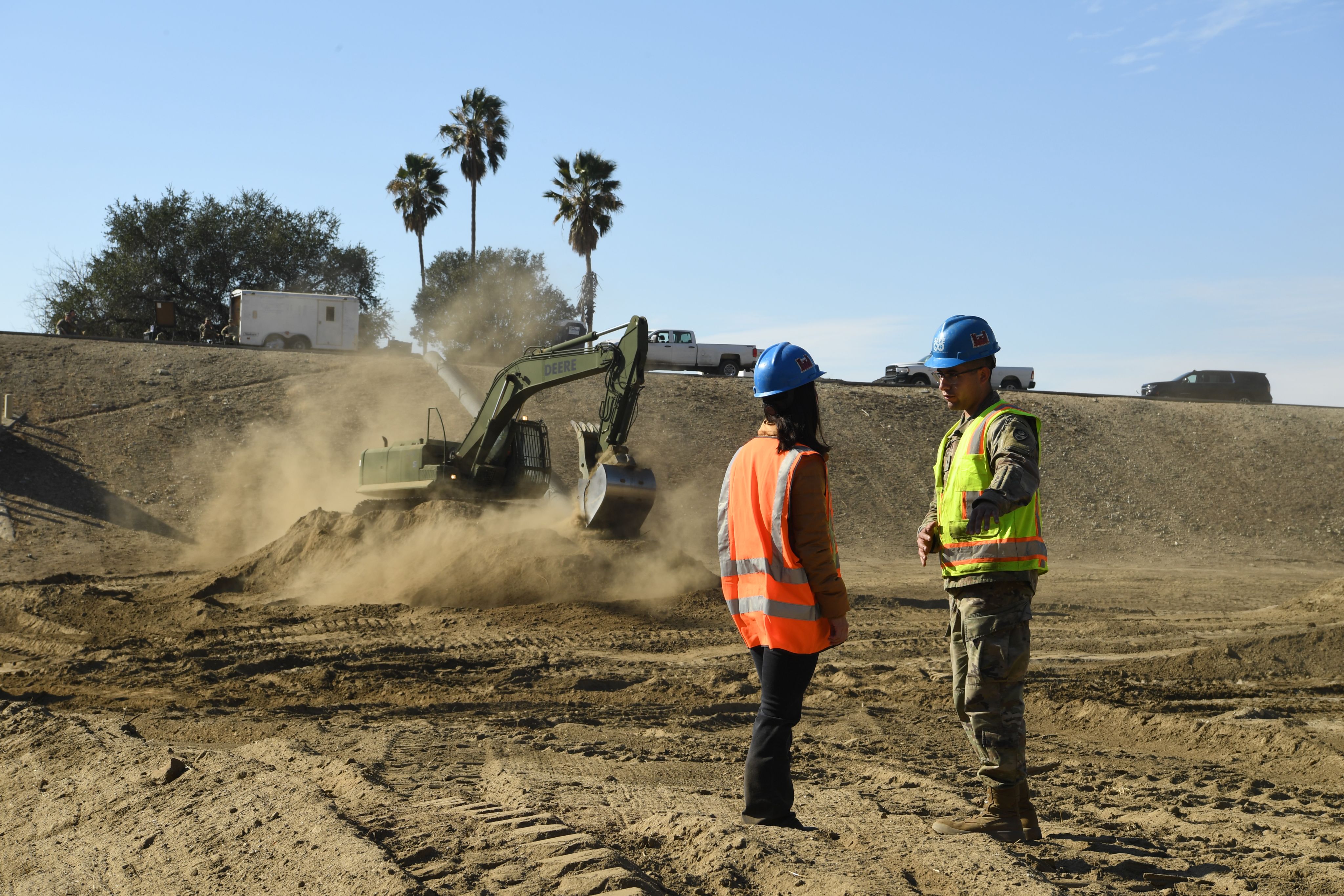Catskinners
649th Engineer Company Removes Debris from Basin after Eaton Fire

by Spc. Elizabeth Buck
69th Public Affairs Detachment
Jan. 29, 2025
LOS ANGELES -- In the 19th century, drivers of mule or horse teams used whips to keep the animals moving. They could skin the hide from the mules using these whips, so they were given the moniker muleskinners. In this century, someone who drives a Caterpillar tractor is called a catskinner.
For the 649th Engineer Company, who are based out of Chico, Calif., the catskinner name was transposed into Wildcats in reference to California State University Chico. Thus they became Task Force Wildcats when they were mobilized to prepare the Sierra Madre Villa Debris Basin for heavy rains and potential mudslides after the Eaton Fire in Pasadena, Calif., Jan. 18, 2025.
The Sierra Madre Villa Debris Basin is a flood control structure near Pasadena, Calif. When cleared of sediment, it has a storage capacity of 51 acre-feet, which equals 16 million gallons of water. 16 million gallons of water is equivalent to 32 Olympic-size swimming pools.
However, this basin wasn’t the first option. The commander and first sergeant of Task Force Wildcats, Capt. Garrett Sawtelle and 1st Sgt. Michael Stillwell, spent two days surveying different basins with L.A. County Department of Public Works. The Sierra Madre Villa Debris Basin was one of only two that could accommodate the engineers’ equipment. Their equipment consisted of two bulldozers, one excavator, one five-yard loader, four dump trucks, and two water tenders.
Stillwell emphasized that moving this equipment requires much planning. Once they moved their equipment, they waited two days for approval to start moving sediment. This is a highly unusual timeline given that projects like this typically require months of planning and research before any equipment begins moving.
“We moved before everything was researched,” said U.S. Army 2nd Lt. Parker Spencer, the 649th Engineer Company’s platoon leader. Though they moved early, they could not begin work until Jan. 22.
The 649th Engineer Company worked alongside the 1401st Engineer Platoon and the 132nd Engineer Battalion at the behest of L.A. County Department of Public Works and Cal OES. U. S. Army Capt. Garrett Sawtelle, the task force commander, explained that the county tries to maintain debris basins below 25% capacity. When Wildcats began work, the Sierra Madre Villa Debris Basin was over 25%.
“We’re trying to maximize its capacity in the event there is heavy rainfall,” said Sawtelle.
Wildfires like the Eaton Fire can lead to hazardous debris flow and landslides due to the fire burning away vegetation that would normally absorb rainfall. Debris basins are intended to catch some of the debris flow from fire-affected mountains to mitigate landslide damage.
Some of the Task Force Wildcats Soldiers had previously been activated for search and rescue operations after deadly mudslides in Santa Barbara County in early 2018. The Thomas Fire left the area vulnerable to heavy rainfall which caused debris to flow from the Santa Ynez Mountains. These mudslides caused the destruction of more than 100 homes and damaged 300 more as well as the deaths of 23 people.
Therefore, the Wildcats’ work in the Sierra Madre Villa Debris Basin is critical to prevent further loss of life and property to the already devastated county.
However, the Wildcats faced some challenges during their mission. Beyond the logistical hurdles task force leadership had to overcome, the sediment in the basin proved difficult for the vehicle operators to navigate.
“It’s pretty soft,” said Spc. James Howard, a horizontal construction engineer with the 649th Engineer Company. “If you’re running the dozer, you have to be careful… you can dig a hole, which is not the goal.”
Another challenge is maintaining the equipment itself. Wherever heavy equipment is used, a team of mechanics is not far behind.
Sgt. Karen Noyes, a heavy equipment construction mechanic and a team leader with the 649th Engineer Company, explained that coolant and tire maintenance demanded the most attention from the team of mechanics.
For Noyes, equipment issues were training opportunities, such as repairing a door on one of the dump trucks. She used her experience as a full-time technician and prior activations for flood missions to help train her team of three other mechanics.
“My guys are new, they don’t have the experience, and I do,” said Noyes, “so I’m teaching them how to do things.”
Noyes expressed her love for the work, having volunteered for this mission before it became mandatory for her unit.
“It’s one thing seeing my work just in the shop or out here and then actually seeing my operators go and use the equipment,” said Noyes.
Thanks to the hard work of all the Wildcats, they completed their mission on Jan. 28, 2025. They completed 441 dump truck runs, totaling 3,435 cubic yards of debris removed. That’s equivalent to more than 800 African bush elephants in weight.
But the Wildcats’ work is not done. They continue digging in a similar mission at the nearby Eaton Canyon Reservoir.
Soldiers with the 649th Engineer Company inspect equipment staged at the Sierra Madre Villa Debris Basin, Jan. 21, 2025. (Photo by Spc. Elizabeth Buck)
Soldiers with the 649th Engineer Company inspect equipment staged at the Sierra Madre Villa Debris Basin, Jan. 21, 2025. (Photo by Spc. Elizabeth Buck)
Soldiers with the 649th Engineer Company take a break from work at the Sierra Madre Villa Debris Basin, Jan. 23, 2025. (Photo by Spc. Elizabeth Buck)
Soldiers with the 649th Engineer Company take a break from work at the Sierra Madre Villa Debris Basin, Jan. 23, 2025. (Photo by Spc. Elizabeth Buck)
A Soldier with the 649th Engineer Company operates an excavator at the Sierra Madre Villa Debris Basin, Jan. 25, 2025. (Photo by Airman 1st Class Frederick Chung)
A Soldier with the 649th Engineer Company operates an excavator at the Sierra Madre Villa Debris Basin, Jan. 25, 2025. (Photo by Airman 1st Class Frederick Chung)
The 649th Engineer Company platoon leader guides a CNN reporter through the debris basin, Jan. 25, 2025. (Photo by Airman 1st Class Frederick Chung)
The 649th Engineer Company platoon leader guides a CNN reporter through the debris basin, Jan. 25, 2025. (Photo by Airman 1st Class Frederick Chung)






